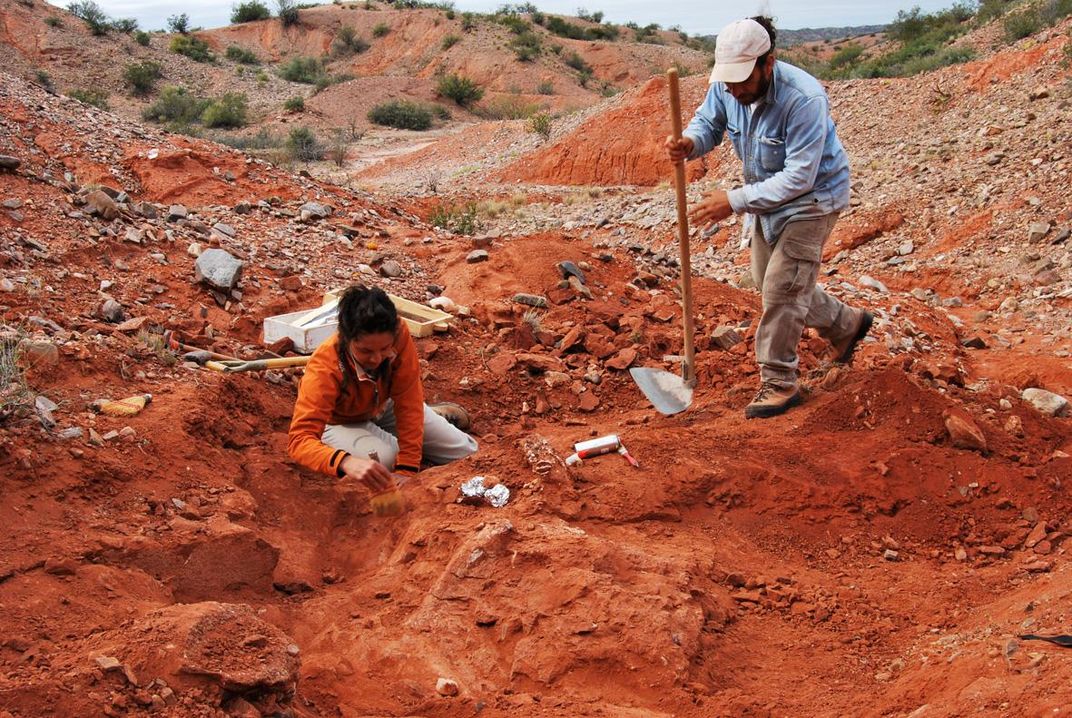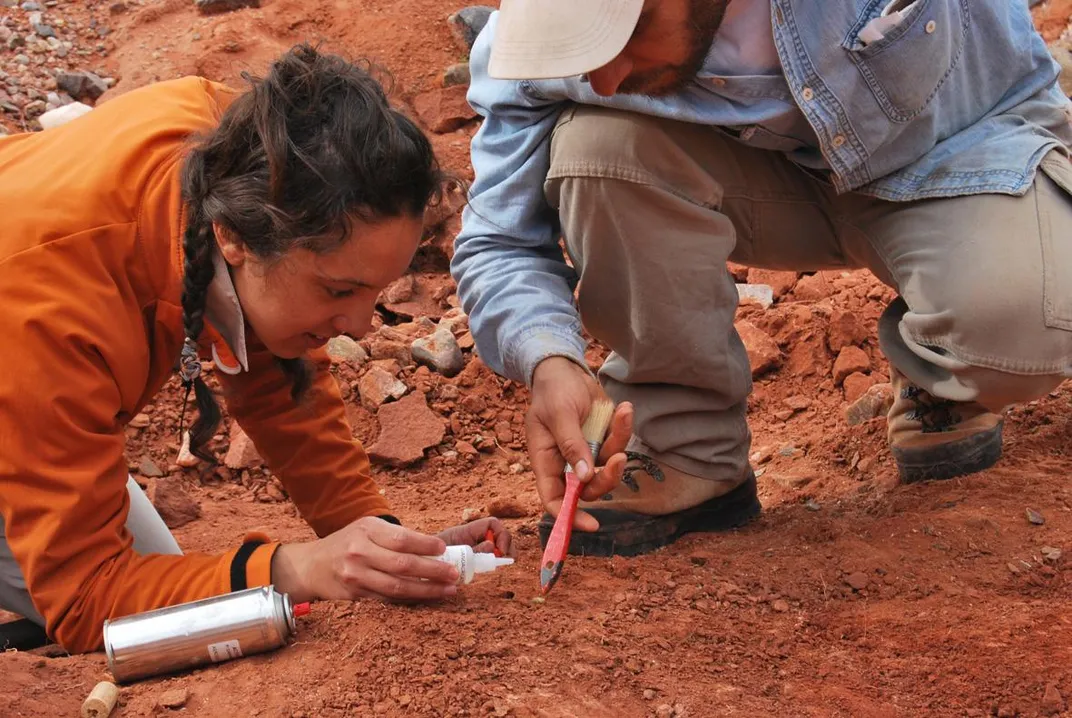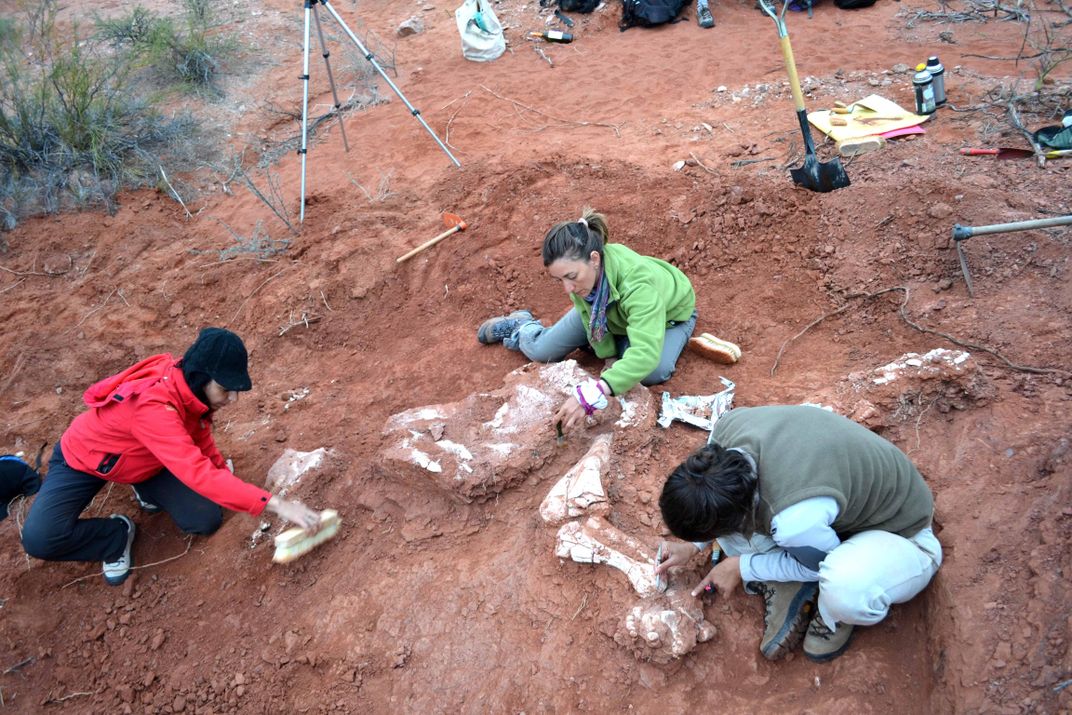The Most Massive of Dinos Evolved Earlier Than Previously Thought
A Triassic giant unearthed in Argentina suggests that dinosaurs took the path to greatness at least twice
/https://tf-cmsv2-smithsonianmag-media.s3.amazonaws.com/filer/dc/67/dc67d348-aed8-42d8-beda-814280f6aaee/19-_ingentia_6.jpg)
Dinosaurs include some of the largest, mightiest animals ever to walk the Earth. Every couple of years, it seems, we’re introduced to a new fossil contending for the biggest ever. So it can be easy to forget that it took many millions of years for these supersized saurians to evolve; the earliest creatures we call dinosaurs were only about the size of a German shepherd.
Thanks to the incomplete nature of the fossil record, scientists are still scratching their heads over exactly when and why giant dinosaurs first appeared. Now the remains of an unusually-large-for-its-time dinosaur found in Argentina provides new insight into the evolution of hugeness—and suggest that the way dinos like Brontosaurus got large wasn’t the only way to do it.
In 2015, while exploring northwestern Argentina’s Marayes-El Carrizal Basin, fossil technician Diego Abelín from the Universidad Nacional de San Juan discovered the bones of a surprisingly large dinosaur. The fossil would turn out to include six neck vertebrae, part of the right shoulder blade, and most of the right forelimb. By testing them at the lab, Abelín and his colleagues would determine that the dinosaur these bones belonged to an animal that had before been seen. In Nature Ecology & Evolution, Universidad Nacional de San Juan paleontologist Cecilia Apaldetti of the Universidad Nacional de San Juan, Abelín and colleagues named the animal Ingentia prima.
Within the many branches and twigs of the dinosaur family tree, Ingentia is classified as a sauropodomorph—the broad group that not only contains familiar giants like Brontosaurus, but also their cousins and ancestors going far back into the Triassic. Triassic sauropodomorphs actually looked quite a bit different from their more famous, later relatives. Some were tiny. Many were bipedal. They hadn’t yet evolved the supportive, column-like limbs associated with big bodies.
This is what makes Ingentia so remarkable. Assuming normal sauropodomorph proportions, Apaldetti estimates that the living animal would have been between 26 and 33 feet long and weigh around 10 tons, or as much as two or three African elephants. In Triassic terms, this is enormous. “Ingentia exceeds three times the size of the largest Triassic dinosaurs known to date,” Apaldetti says.
Despite the fact that the Triassic is often called the “Dawn of the Dinosaurs,” most dinosaurs in this era were pipsqueaks. Carnivorous dinosaurs were turkey-sized, while the ancestors of the likes of Stegosaurus and Triceratops were similarly small-bodied. It was only in the later part of the Triassic that the sauropodomorphs started to push the limits of bigger body sizes, diversifying into a wide range of forms that caused a major evolutionary shift: From small, bipedal ancestors, sauropodomorphs like Ingentina became quadrupedal giants.
The new finding pushes back the emergence of giant body size. Until now, University of Witwatersrand paleontologist Jonah Choiniere says, the largest known sauropodomorph was an animal called Antetonitrus from the Jurassic. “The appearance of animals of slightly larger body size appearing much earlier is really interesting,” Choiniere says—particularly because increasing dinosaur body size and different shapes occurred prior to the end-Triassic mass extinction that was thought to finally give dinosaurs a competitive edge.
So now we know that sauropodomorphs grew to giant sizes at least twice. And interestingly, the Traissic giants may reveal a different route to getting big.
Until now, Apaldetti says, it was thought that truly giant dinosaurs didn’t evolve until about 180 million years ago. This is when the quadruped, column-limbed sauropods started their Jurassic inflation—think Brachiosaurus and Apatosaurus as Late Jurassic examples of this body type. “But Ingentia prima lived at the end of the Triassic, between 210 and 205 million years ago,” Apaldetti says.
What’s fascinating to paleontologists isn’t just when these saurs got their growth spurt in evolutionary time—it’s how they grew in the dinosaurs’ lifespans. Like virtually all dinosaurs, sauropodomorphs like Ingentia hatched out of relatively small eggs. When Apaldetti and colleagues looked at Ingentia and related dinosaurs called Lessemsaurids, though, they found that these dinosaurs didn’t grow the same way as their later relatives.
Previous studies showed that dinosaurs like Diplodocus grew rapidly and continuously to get to huge sizes. Giants in the Traissic did things differently. Their growth was seasonal: they packed on the pounds when the seasons were favorable and stopped growth when conditions took a turn, like trees. This actually helped them increase their size “at a speed even higher than that of the giants that grew continuously,” Apaldetti notes.
There was more to this strategy. The lessemsaurids included in the study had a bird-like respiratory system, including air sacs that invaded bones to make skeletons lighter without sacrificing strength (as well as making breathing more efficient and acting as an internal cooling system). Paleontologists have long known that later sauropods benefitted from these structures, but the new research indicates they were a critical part of Triassic sauropodormoph biology, too. “Ingentia and its closest relatives show that just growing extremely rapidly and an improved avian-like respiratory system was necessary to achieve big body size at an early moment of their evolutionary history,” says Apaldetti.
Bones can help illuminate the biological features that allowed dinosaurs to get big, like air sacs and rapid growth rates. But the environmental reasons why the Triassic was a good time to get big are still hazy. There probably wasn’t a single reason, Apaldetti says, but several, such as higher temperatures and more nutritious plants. “I would suggest that higher global temperatures and greater primary productivity of plants are likely what drove body size evolution,” Choiniere adds, “but at this point that hypothesis still needs testing.”
For now, the discovery of Ingentia adds to the deep significance of the Triassic. This was not only the time of the first giant dinosaurs, dome-headed weirdos and vacuum-faced oddities, but also when the ancestors of animals alive today—birds, crocodiles, mammals—flourished. It was a time of exuberant and varied life that set up the following 200 million years, with creatures like Ingentia underscoring how ancient diversity set up what would later come into being.
“Evidently,” Apaldetti says, “the Triassic period was a lab for vertebrates, the moment in which most of the current vertebrate groups were designed and re-designed” by the chaotic whims of evolution.
/https://tf-cmsv2-smithsonianmag-media.s3.amazonaws.com/accounts/headshot/RileyBlack.png)



/https://tf-cmsv2-smithsonianmag-media.s3.amazonaws.com/accounts/headshot/RileyBlack.png)